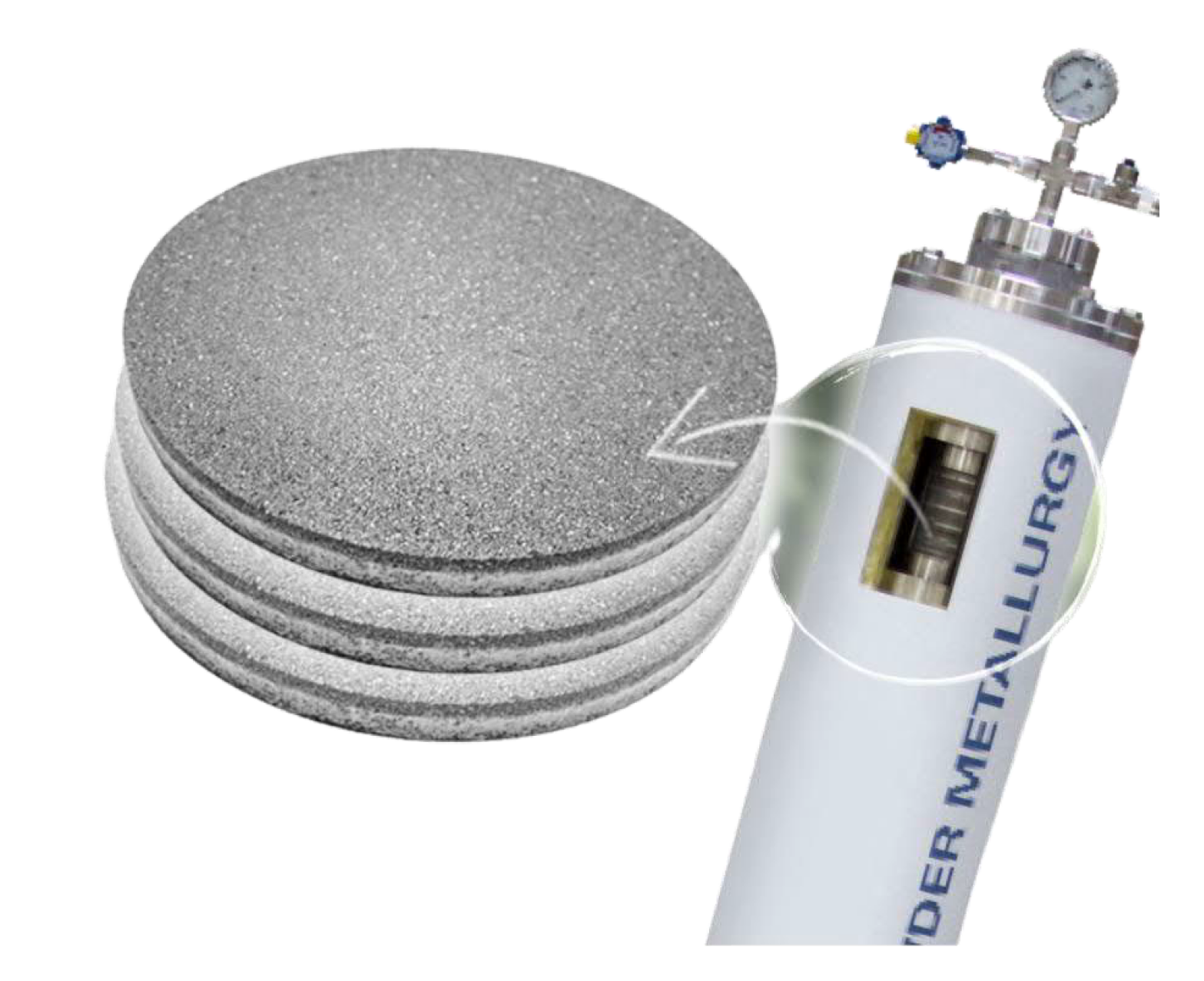Safe Hydrogen Storage - Metal Hydride Systems - Storage Solutions
"Yes, my friends, I believe that someday water will be employed as fuel, that hydrogen and oxygen which constitute it, used singly or together, will furnish an inexhaustible source of heat and light, of an intensity of which coal is not capable." Jules Verne, The Mysterious Island - 1874
GKN Hydrogen - The Future of Green Energy - Time for Action
Together, we can combat climate change and air pollution, for ourselves and for future generations. Every year, the world's demand for energy increases. Today, solar, wind, and water energy can supply more energy than we need. Unfortunately, this green energy is not always available when we need it. The solution to this problem is storage. This is where GKN Hydrogen comes in. Our green hydrogen storage solution is the most reliable system on the market. Thanks to its modular structure, it can be flexibly adapted to virtually any storage requirement. Green energy from wind, water, and sun is transformed into hydrogen. Hydrogen molecules flow into the storage center and are securely absorbed into the metal mesh. Metal hydrides can survive for decades without loss and are the most reliable and safe way to store hydrogen. When we need energy, hydrogen is released from the storage and converted back into electricity and heat. The heat produced in this process can also be utilized, significantly increasing the efficiency of the entire system. The only by-product of this process is pure water. GKN Hydrogen provides safe, green energy to residential, industrial, and transportation sectors, whether it's for microgrids, emergency power systems, or energy conversion plants. The possibilities are endless. Climate protection on a global scale is our mission. Transitioning to renewable energy is the answer for pioneers, trendsetters, and innovators, for people who want to save the world, for a better tomorrow.
All video
Our "All-In-One" Hydrogen Storage Solutions
"Power 2 Power" provides electrical energy or heat when needed, while "hydrogen storage" offers long-term hydrogen storage that can be used directly for industrial purposes.
Power 2 Power
By harnessing excess hydrogen produced by renewable sources and storing it until needed, our HY2MINI and HY2MEDI storage solutions offer two options.
Hydrogen can be converted into energy when needed, or it can be directly converted into heat capable of heating homes.

HY2MINI - 10ft Container
If you need a reliable proof of concept for small-scale hydrogen projects, HY2Mini is the perfect solution. It is easy to install and highly flexible, making it excellent for new customers exploring hydrogen energy in smaller applications. HY2Mini utilizes state-of-the-art hydrogen fuel cell technology for efficient and reliable power.


All video
Unique Advantages of HY2MINI Hydrogen Storage
- Fully recyclable
- Fully safe - hydrogen storage in solid state under maximum pressure of 40 bar
- Higher energy-to-space ratio compared to batteries or compressed gas storage
- 30-year service life with energy storage capacity retained throughout life
- No need for a compressor
Requirements
- Concrete foundation (building permit)
- Interface points (input: PV, wind... / output: power line)
- Mode of operation determination (autonomous, grid parallel, emergency power)
- Application to certification body
HY2MINI Hydrogen Storage in a Mountain Shelter
All video
HY2MEDI - 20ft Container
HY2MEDI is the perfect solution for energy needs at small and medium scales. This system offers flexibility and safety as a backup power source or for microgrids. It can also be configured to provide both electrical and thermal energy, maximizing its utility in various conditions.


Unique Advantages of HY2MEDI Hydrogen Storage
- Fully recyclable
- Fully safe - hydrogen storage in solid state under maximum pressure of 40 bar
- Higher energy-to-space ratio compared to batteries or compressed gas storage
- 30-year service life with energy storage capacity retained throughout life
- No need for a compressor
Requirements
- Concrete foundation (building permit)
- Interface points (input: PV, wind... / output: power line, heat recovery line)
- Mode of operation determination (autonomous, grid parallel, emergency power)
- Application to certification body
HY2MEGA
HY2MEGA is the ultimate solution for larger hydrogen storage needs in public utility scales or decarbonizing hard-to-avoid sectors. Its modular design maximizes storage capacity and can be easily integrated into existing electrolysis processes. With HY2MEGA, the potential of green hydrogen as an industrial raw material can be utilized, contributing to a cleaner, more sustainable future.

Unique Advantages of HY2MEGA Hydrogen Storage
- 100% recyclability
- 100% safety - hydrogen storage in solid state under maximum pressure of 40 bar
- Higher energy-to-space ratio compared to batteries or compressed gas storage
- Expected storage life of 30 years with energy storage capacity retained throughout life
- No need for a compressor
Requirements
- Concrete foundation (building permit)
- Mode of operation determination (autonomous, grid parallel, emergency power)
- Application to certification body
The HY2MEGA system requires an electrolyzer and fuel cell - link
Hydrogen Storage System + Thermal Management
Tank and Transport of Hydrogen

How Do We Store Hydrogen
Green hydrogen is a key energy carrier driving the decarbonization of buildings, infrastructure, and industry. As pioneers in the field of hydrogen, we develop the safest hydrogen storage systems and help customers worldwide achieve their climate goals.
Green energy from wind, water, and sunlight is converted into hydrogen, and hydrogen molecules are solidly absorbed into a metal lattice.
Metal hydrides can survive for decades without losses, being the most reliable and safe way to store hydrogen. When energy is needed, hydrogen is released from the storage and converted back into electricity and heat.
Seasonal Energy Storage
Today, there is an intense discussion about climate change and high levels of CO2 in the Earth's atmosphere. High CO2 levels result from burning fossil fuels to power our vehicles and generate electricity for industry and homes. With the increasing population and development of more countries, CO2 levels will continue to rise. The desperate search for non-polluting, renewable energy sources faces three key challenges:
- Sustainable energy generation
- Efficient energy transfer
- Effective energy storage
The challenges have spurred creative new solutions for generating more sustainable energy. However, regulations and costs make it difficult. Decentralized photovoltaic solar panels are common in many European countries and have had at least 15 years of public incentives to help adopt this technology.
However, due to the lack of decentralized, efficient, and affordable storage systems, energy is mainly supplied to the public grid rather than used locally. In this way, in many cases, sustainably generated energy is not utilized because its availability does not meet the requirements of reliable and predictable power supply. Local direct use requires new and more efficient energy transfer and storage.
Private owners of photovoltaic solar panels depend on electricity suppliers. In the local system, surplus electricity from photovoltaic solar panels or other sustainable sources is stored during the day and used throughout the night.
Currently, batteries are used for daily energy buffers. Battery storage systems ranging from 3 kWh to 14 kWh are suitable since the electricity demand for a home is about 11 kWh per day. The cost of such a battery system has recently dropped to €30/kWh based on the concept of Tesla Powerwall 2. Although this sounds economical, battery costs quickly escalate when creating a buffer system for seasonal energy. For a residential system, roughly one-third of the annual electricity demand should be stored in the summer to be available in winter. The annual electricity demand for a four-person household is about 4000 kWh/year, not including additional heating energy. Thus, the battery capacity for seasonal electricity buffer is 1300 kWh.
Scaling up such a battery solution would cost around €560,000, making battery storage less attractive.
A better solution for large-scale energy storage is a hydrogen-based system. The system consists of three main modules:
- Hydrogen production
- Hydrogen storage
- Converting hydrogen into electrical energy
Hydrogen can store more kWh per volume than batteries. Increased energy density reduces the costs and size of larger energy systems, making the hydrogen solution ideal for seasonal energy storage.

Hydrogen production for energy storage using electricity is about 50% efficient. Converting stored hydrogen back into electrical energy is roughly the same.
Therefore, the electrical efficiency of the hydrogen system is only 25%. Fortunately, our engineers are creative. They recognized that the primary energy demand of a home is not only electricity but also heat. Heating accounts for nearly twice as much energy compared to electricity. Generating heat energy using the hydrogen system increases its efficiency to 90%. This is comparable to the efficiency of battery systems and is more cost-effective.
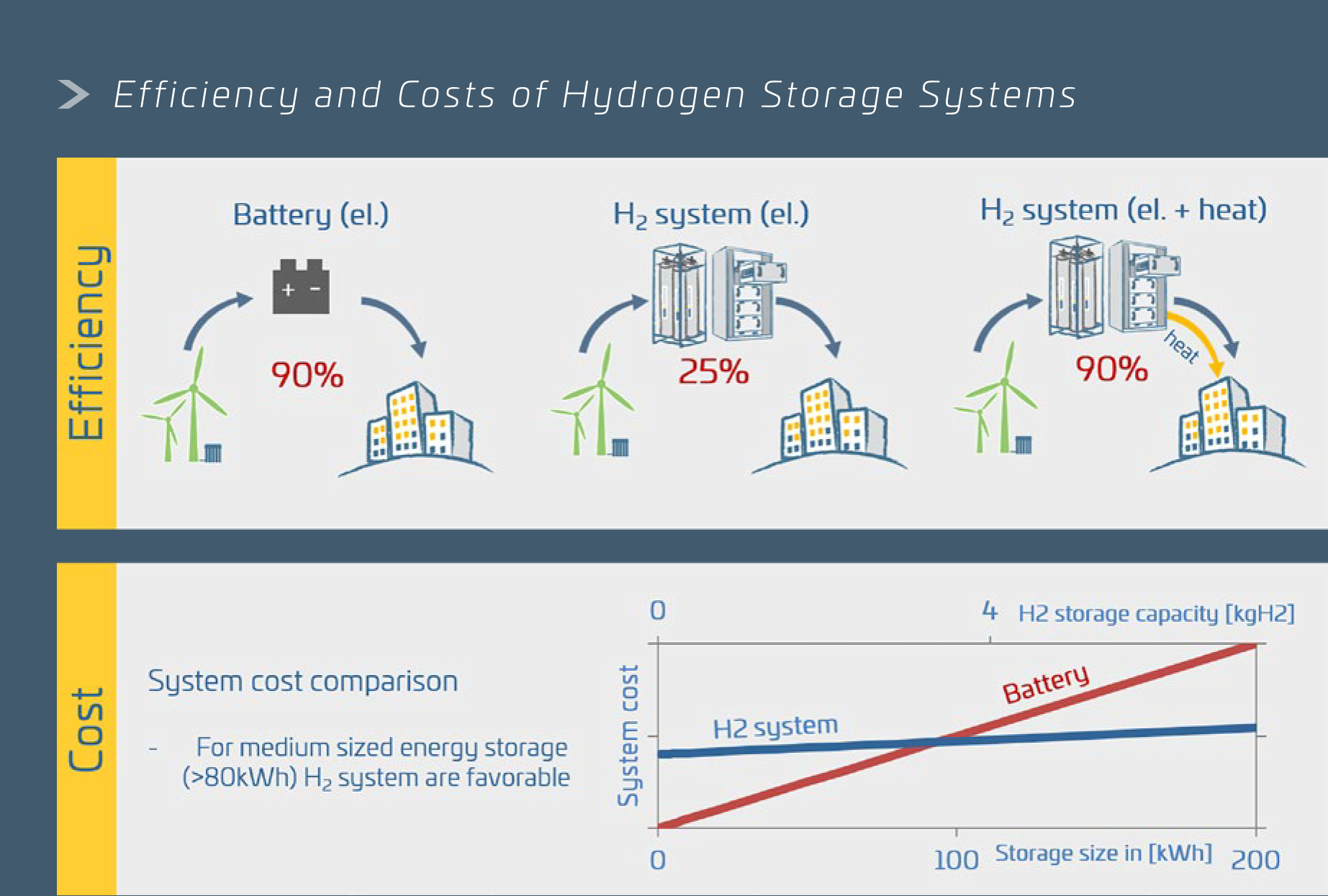
Hydrogen is typically stored in two ways:
- For stationary applications, hydrogen is stored in pressure tanks at around 40 bar and even 300-500 bar
- For mobile applications, hydrogen is stored in pressure tanks above 300 bar
Hydrogen Compression Consumes Large Amounts of Energy
Our engineers were challenged to find a more efficient solution. They developed a new metal alloy powder from hydrides. By compacting the alloy powder into high-density pellets, we created an efficient material for storing hydrogen in solid form.
Next Generation Hydrogen Storage with Metal Hydride Technology

100% recyclable: Metal hydrides are often made from abundant and non-toxic materials, making them environmentally friendly and sustainable compared to other storage technologies.
Only 5% stored in gas form: Metal hydrides are generally stable materials and provide a safer alternative to compressed hydrogen gas or liquid hydrogen, which are more prone to leakage or explosion. Up to 15 times smaller storage sizes due to high material density. Metal hydrides can store a significant amount of hydrogen in a relatively small volume compared to other storage methods, making them suitable for applications where space is limited.
Thermodynamic efficiency: Metal hydride reactions typically occur at moderate temperatures and pressures, leading to higher thermodynamic efficiency compared to other hydrogen storage methods such as compression or liquefaction. Metal hydride storage technology can be adapted to various scales and applications, from small-scale portable devices to large stationary energy storage systems, providing flexibility in deployment.
Metal Hydride Storage - Cross Section
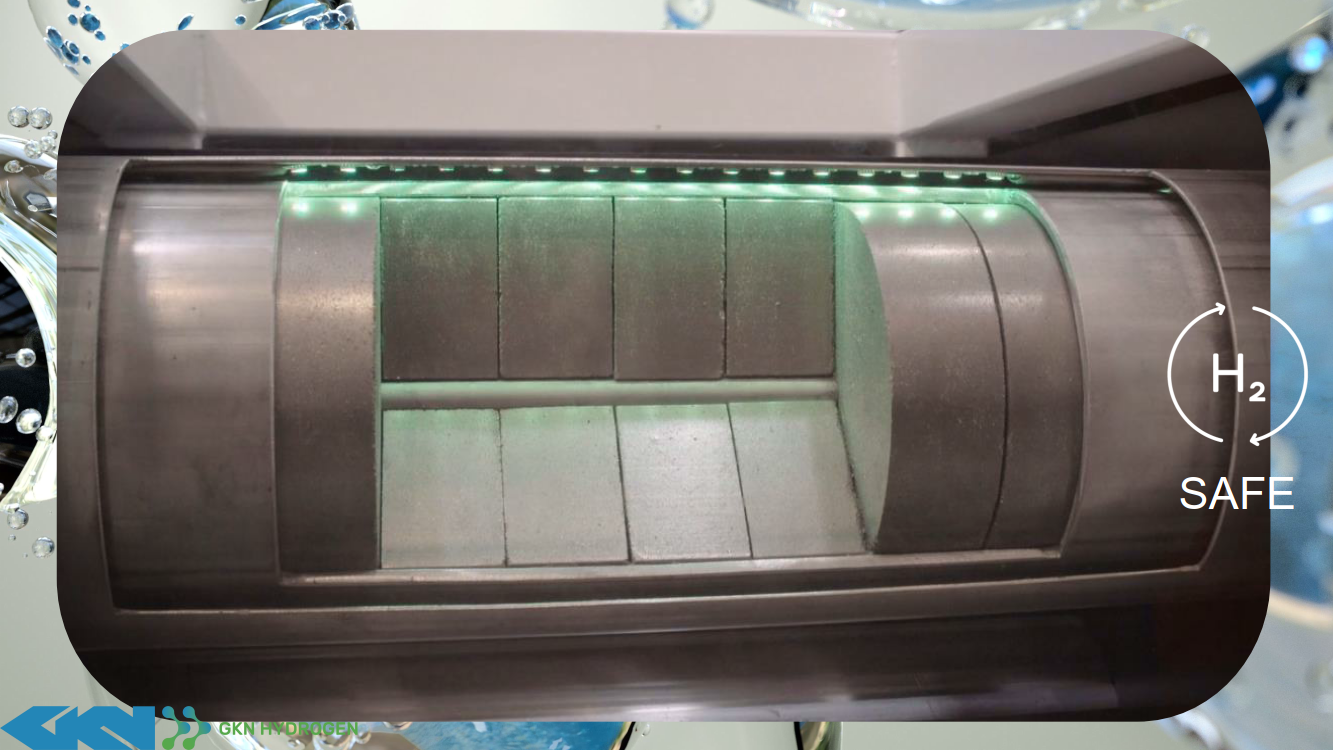
- Low constant pressure
- Low temperature
This is a low-pressure solution with pressure below 30 bar. An advanced alloy and maximum powder surface area provide a cost-effective way to ensure long-term hydrogen charging and discharging.
We found that this new solid-state storage design is more advantageous compared to other hydrogen technologies. Controlling pressure and temperature is important to enable the charging and discharging of the GKN storage system hydrogen.
How to Increase the Utilization of Renewable Energy? Store It as Eco-Friendly Hydrogen and Reuse It on Demand!
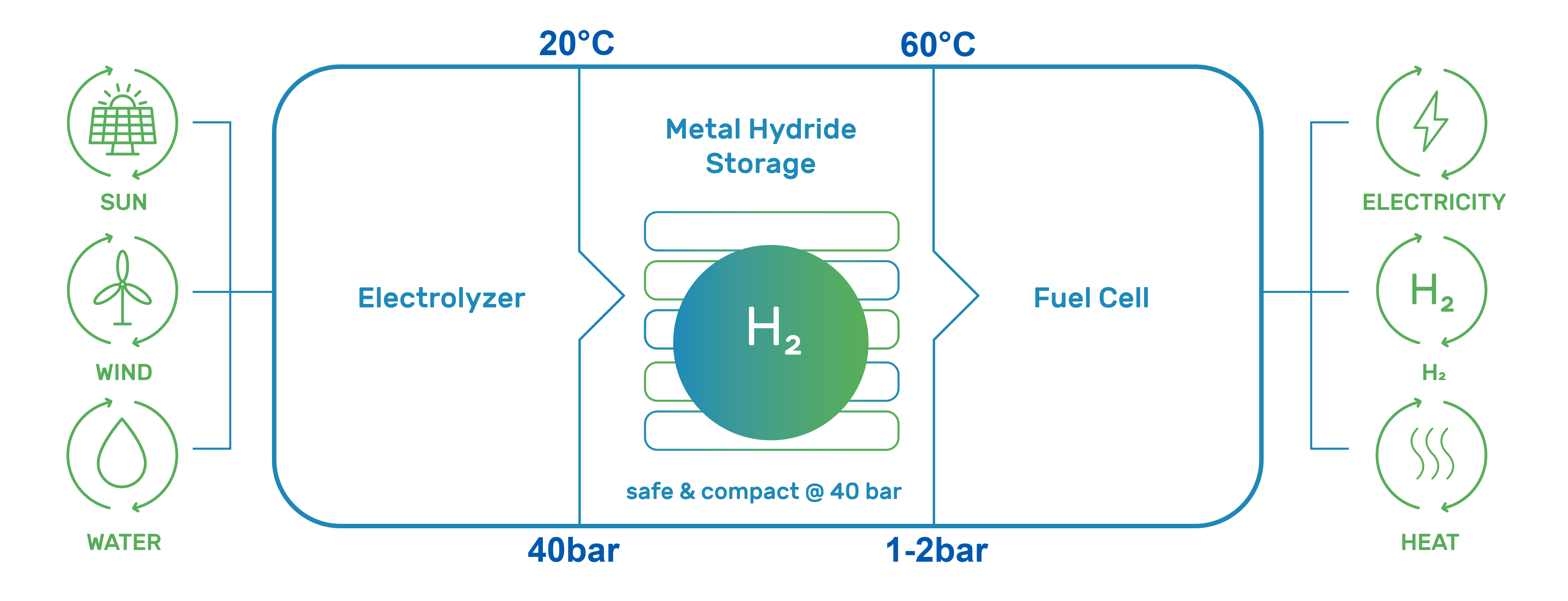
Size? Ultra-Compact, 15 Times Smaller Than 40bar Gas Tanks.
Storage of 1 kg H2 – Size Comparison of Storage
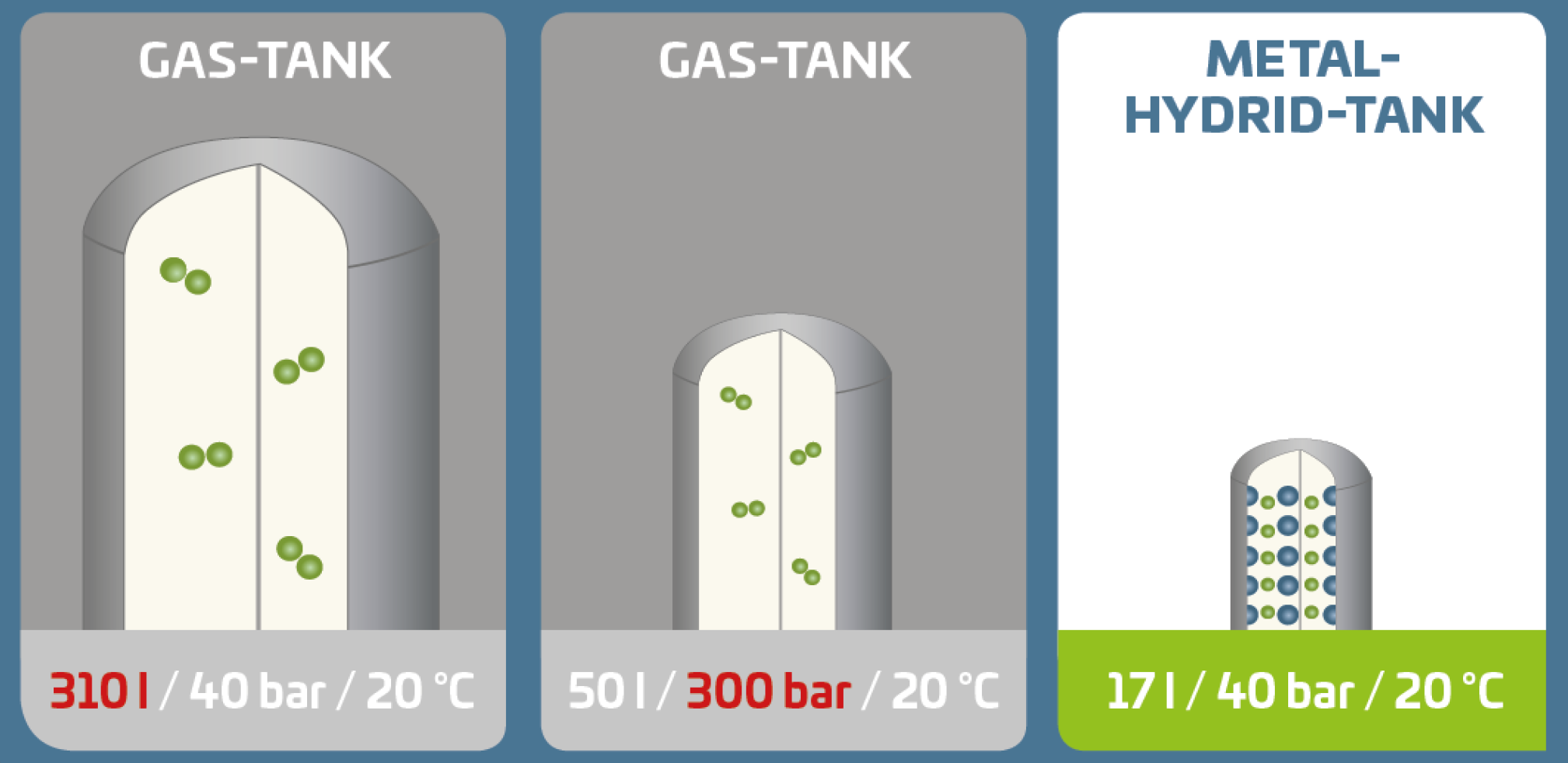
Long Lifetime - 99% Capacity After 3500 Cycles
- High cycle count
- No degradation
- No hydrogen loss over time
All video
```








